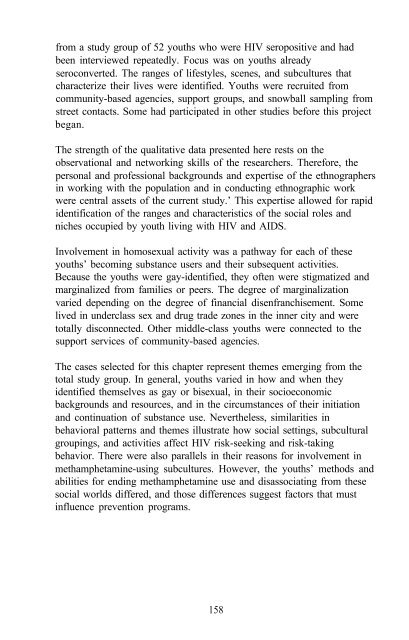The Context of HIV Risk Among Drug Users and Their Sexual Partners
The Context of HIV Risk Among Drug Users and Their Sexual Partners
The Context of HIV Risk Among Drug Users and Their Sexual Partners
You also want an ePaper? Increase the reach of your titles
YUMPU automatically turns print PDFs into web optimized ePapers that Google loves.
from a study group <strong>of</strong> 52 youths who were <strong>HIV</strong> seropositive <strong>and</strong> had<br />
been interviewed repeatedly. Focus was on youths already<br />
seroconverted. <strong>The</strong> ranges <strong>of</strong> lifestyles, scenes, <strong>and</strong> subcultures that<br />
characterize their lives were identified. Youths were recruited from<br />
community-based agencies, support groups, <strong>and</strong> snowball sampling from<br />
street contacts. Some had participated in other studies before this project<br />
began.<br />
<strong>The</strong> strength <strong>of</strong> the qualitative data presented here rests on the<br />
observational <strong>and</strong> networking skills <strong>of</strong> the researchers. <strong>The</strong>refore, the<br />
personal <strong>and</strong> pr<strong>of</strong>essional backgrounds <strong>and</strong> expertise <strong>of</strong> the ethnographers<br />
in working with the population <strong>and</strong> in conducting ethnographic work<br />
were central assets <strong>of</strong> the current study.’ This expertise allowed for rapid<br />
identification <strong>of</strong> the ranges <strong>and</strong> characteristics <strong>of</strong> the social roles <strong>and</strong><br />
niches occupied by youth living with <strong>HIV</strong> <strong>and</strong> AIDS.<br />
Involvement in homosexual activity was a pathway for each <strong>of</strong> these<br />
youths’ becoming substance users <strong>and</strong> their subsequent activities.<br />
Because the youths were gay-identified, they <strong>of</strong>ten were stigmatized <strong>and</strong><br />
marginalized from families or peers. <strong>The</strong> degree <strong>of</strong> marginalization<br />
varied depending on the degree <strong>of</strong> financial disenfranchisement. Some<br />
lived in underclass sex <strong>and</strong> drug trade zones in the inner city <strong>and</strong> were<br />
totally disconnected. Other middle-class youths were connected to the<br />
support services <strong>of</strong> community-based agencies.<br />
<strong>The</strong> cases selected for this chapter represent themes emerging from the<br />
total study group. In general, youths varied in how <strong>and</strong> when they<br />
identified themselves as gay or bisexual, in their socioeconomic<br />
backgrounds <strong>and</strong> resources, <strong>and</strong> in the circumstances <strong>of</strong> their initiation<br />
<strong>and</strong> continuation <strong>of</strong> substance use. Nevertheless, similarities in<br />
behavioral patterns <strong>and</strong> themes illustrate how social settings, subcultural<br />
groupings, <strong>and</strong> activities affect <strong>HIV</strong> risk-seeking <strong>and</strong> risk-taking<br />
behavior. <strong>The</strong>re were also parallels in their reasons for involvement in<br />
methamphetamine-using subcultures. However, the youths’ methods <strong>and</strong><br />
abilities for ending methamphetamine use <strong>and</strong> disassociating from these<br />
social worlds differed, <strong>and</strong> those differences suggest factors that must<br />
influence prevention programs.<br />
158
















